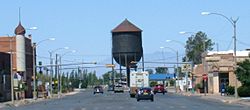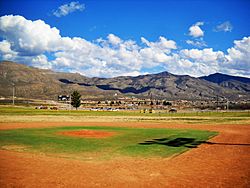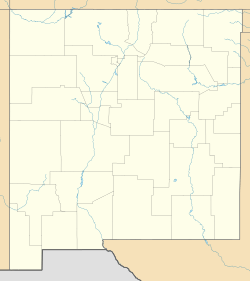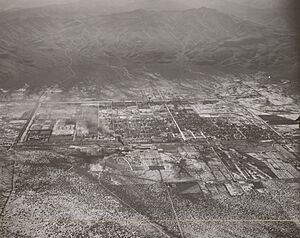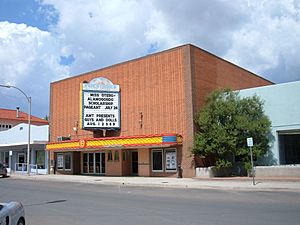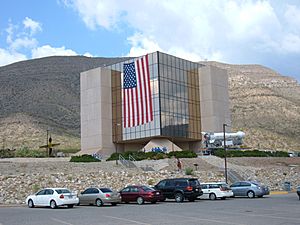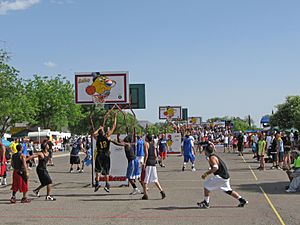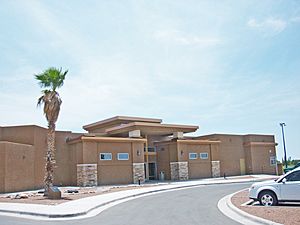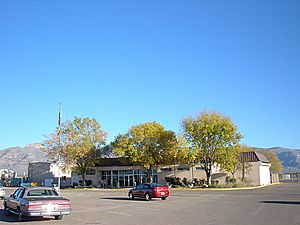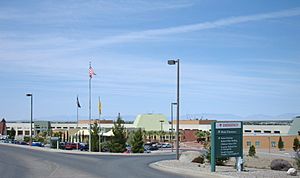Alamogordo, New Mexico facts for kids
Quick facts for kids
Alamogordo, New Mexico
|
|
|---|---|
|
Downtown Alamogordo, looking west on 10th Street; Jim Griggs Sports Complex; Shops on New York Avenue; Water Tower looking east on Tenth Street; Kids' Kingdom Park; View of Alamogordo from Thunder Road
|
|
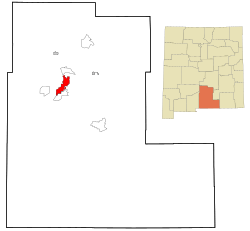
Location in New Mexico
|
|
| Country | United States |
| State | New Mexico |
| County | Otero |
| Founded | 1898 |
| Incorporated | 1912 |
| Named for | álamo gordo, Spanish for "fat cottonwood" |
| Government | |
| • Type | Commission–manager |
| Area | |
| • Total | 21.58 sq mi (55.90 km2) |
| • Land | 21.57 sq mi (55.87 km2) |
| • Water | 0.01 sq mi (0.03 km2) |
| Elevation | 4,311 ft (1,314 m) |
| Population
(2020)
|
|
| • Total | 31,384 |
| • Density | 1,432.32/sq mi (553.02/km2) |
| Time zone | UTC−7 (Mountain Standard Time Zone) |
| • Summer (DST) | UTC−6 (Mountain Daylight Time) |
| ZIP codes |
88310, 88311 (PO Box)
|
| Area code(s) | 575 |
| FIPS code | 35-01780 |
| GNIS feature ID | 2409672 |
Alamogordo is a city in New Mexico, United States. It is the main city of Otero County. The city is located in the Tularosa Basin desert area. It is near the Sacramento Mountains and Holloman Air Force Base. In 2020, about 31,384 people lived there.
Alamogordo is famous for its connection to the 1945 Trinity test. This was the first time an atomic bomb was ever exploded. People have lived in this area for at least 11,000 years. The city we see today was started in 1898. It was built to help with the construction of the El Paso and Northeastern Railroad. It was one of the first "planned communities," meaning it was designed carefully from the start. The city officially became a city in 1912.
Tourism became very important after White Sands National Monument was created in 1933. This park is still a big attraction today. In the 1950s and 1960s, Alamogordo was a key place for research on pilot safety and the early U.S. space program.
Alamogordo has a city government run by a commission and a manager. The city offers many fun places for its citizens. These include a large park, smaller parks, a golf course, the Alameda Park Zoo, walking paths, the Alamogordo Public Library, and a center for older adults. The Gerald Champion Regional Medical Center is a hospital that serves both civilians and military personnel from Holloman Air Force Base.
Contents
History of Alamogordo
The Tularosa Basin has been home to people for at least 11,000 years. Ancient groups like the Clovis culture and Folsom culture lived here. The Mescalero Apache people were already living in the Tularosa Basin when the Spanish arrived in 1534.
The city of Alamogordo was founded in June 1898. This happened when the El Paso and Northeastern Railroad extended its tracks to the area. Charles Bishop Eddy, who led the railroad, helped design the city. He wanted wide streets and tree-lined canals. His brother, John Arthur Eddy, named the city. He combined Spanish words to mean "large/fat cottonwood," remembering a grove of trees. When the city was planned, east-west streets got numbers, and north-south streets were named after states.
Tourism grew when White Sands National Monument was created in 1934. In 1935, the Works Progress Administration (WPA), a government program during the Great Depression, built several buildings in Alamogordo. This included the Otero County Administration Building, which was originally the main U.S. Post Office.
In July 1941, the Alamogordo Bombing and Gunnery Range was set up. This area later became important for military testing.
In 1983, Atari, Inc. buried many unsold video game cartridges in Alamogordo's landfill. This included many copies of the game E.T. the Extra-Terrestrial. For a long time, people thought this was just a story. But later, Atari confirmed it, and parts of the landfill were dug up to find the games.
Where is Alamogordo? (Geography)
Alamogordo covers about 19.3 square miles of land. It is located on the western side of the Sacramento Mountains. It is also on the eastern edge of the Tularosa Basin. This area is part of the Chihuahuan Desert. The ground here does not move much, so there are few earthquakes.
Plants that grow naturally here include creosote bush, mesquite, cottonwood trees, and many types of cactus and yucca. The Tularosa Basin is a "closed" basin. This means water flows into it but does not flow out. Because of this, the water in the basin is "hard," meaning it has many dissolved minerals.
The famous white gypsum crystals of White Sands National Park are formed in Lake Lucero. Water from the mountains carries dissolved gypsum into the lake. When the water dries up, the wind picks up the gypsum crystals and spreads them across the basin, creating the white sand dunes.
Alamogordo's Climate
Alamogordo has a dry climate with hot summers and mild winters. It doesn't rain much, and most of the rain falls from July to September. This rainy season is called the monsoon. Summers are very hot, with temperatures often going above 90°F (32°C). Winters are mild and sunny during the day, but nights can be cold. Snow is very rare in Alamogordo.
People of Alamogordo
In 2020, Alamogordo had a population of 31,384 people. The city has a mix of different backgrounds. About 70.4% of the people were White, and 32.0% were Hispanic or Latino.
In 2000, there were 13,704 households in the city. About 36.3% of these households had children under 18 living with them. The average household had about 2.57 people. The median age in the city was 34 years old. This means half the people were younger than 34, and half were older.
German Community in the Past
From 1992 to 2019, Alamogordo had a German community. This was because the German Air Force used Holloman Air Force Base as its main pilot training center in the U.S. There was even a neighborhood called "Little Germany" with houses that had German-style electrical outlets. A school called Deutsche Schule Alamogordo taught German children. Local supermarkets even sold German cuisine.
By 2003, about 2,000 Germans lived in Alamogordo. The German military left the base in 2019. Until then, the German Air Force hosted an annual Oktoberfest celebration at Holloman Air Force Base, and the public was invited.
What is the Economy Like?
Alamogordo is the main economic hub for Otero County. Almost half of the county's population lives in the city. Today, Alamogordo does not have much manufacturing. Its economy mostly relies on services and retail. This is driven by tourism, the large nearby military base, and many military retirees.
Economic History
Alamogordo started as a "company town" to support the building of the El Paso and Northeastern Railroad. At first, its main business was cutting timber for railroad ties. The railroad founders wanted to build a lasting town. They created the Alamogordo Improvement Company to develop the area. This made Alamogordo one of the first planned communities.
Tourism became a big part of the local economy after White Sands National Monument was created in 1934. Construction began on the Alamogordo Army Air Field (now Holloman Air Force Base) in 1942. Since then, the U.S. government has been a strong presence in Alamogordo. Education is also important. Besides the local schools, Alamogordo has the New Mexico School for the Blind and Visually Impaired and a branch of New Mexico State University.
Military's Impact
Holloman Air Force Base, located just west of the city, is the biggest employer for Alamogordo residents. It has a huge effect on the local economy. Some people believe Holloman accounts for half of Alamogordo's economy. In 2008, Holloman directly employed over 6,000 people. It also created thousands of other jobs. The base spends hundreds of millions of dollars in the community each year.
About 6,700 military retirees live in the area. In 2019, the German Air Force left Holloman after 27 years of training there.
Fun Things to Do and See
Alamogordo has two groups that put on plays and musicals. The Alamogordo Music Theatre performs musicals at the Flickinger Center for Performing Arts. The NMSU-A Theatre on the Hill performs plays for young audiences and general audiences.
Annual Events
- The Earth Day Fair is held every year at the Alameda Park Zoo. It has a butterfly release, a science fair, and activities for kids.
- The Otero County Fair happens yearly at the County Fairgrounds. It includes a rodeo, animal judging, food, games, and carnival rides.
- The Cottonwood Arts and Crafts Festival takes place every Labor Day Weekend in Alameda Park. It features handmade items, music, and food.
- The White Sands Balloon Invitational is an annual event where hot air balloons launch and float over the Tularosa Basin.
Visitor Attractions
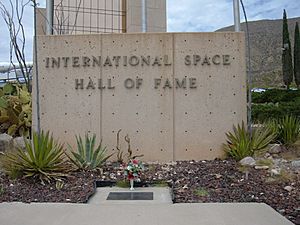
- The New Mexico Museum of Space History is a state museum. It includes the International Space Hall of Fame.
- The Flickinger Center for Performing Arts is a theater that hosts concerts and live shows.
- The Alamogordo Museum of History collects items related to the history of Alamogordo and the Tularosa Basin. It has a rare 47-star U.S. Flag.
- The American Armed Forces Museum displays military items from different wars.
- The Shroud Exhibit And Museum shows a large photo of the Shroud of Turin, a famous religious cloth.
- The Alameda Park Zoo is the oldest zoo in the southwestern U.S. It specializes in animals from the Southwest.
- The Toy Train Depot is New Mexico's first railroad museum. It has toy trains and a park ride train.
- A sculpture called "The World's Largest Pistachio" is at McGinn's PistachioLand.
Sports and Activities
Many sports events happen in Alamogordo. The Lady of the Mountain Run is a race held in December. It raises money for scholarships for students. There are also fun run/walks throughout the year.
- The Tommy Padilla Memorial Basketball Tournament is an annual adult tournament in March. It raises money for high school scholarships.
- The Gus Macker 3-on-3 Basketball Tournament is a national program that holds a tournament in Alamogordo every May. Hundreds of teams participate.
- Several golf tournaments are held at Desert Lakes Golf Course.
Alamogordo had a professional baseball team called the White Sands Pupfish. They played at Jim Griggs Field from 2011 to 2019.
Parks and Recreation
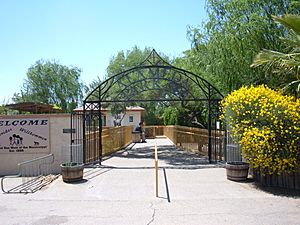
Alamogordo has many parks.
- Alameda Park is a city park with many cottonwood trees. The Alameda Park Zoo and The Toy Train Depot are located here.
- Washington Park is in the center of town. It has City Hall and Kids Kingdom, a large play area for children.
- There are public sports fields at the Jim R. Griggs Sports Complex and the Travis C. Hooser Ballfield Complex.
- The Alamogordo Family Recreation Center has a weight room, swimming pool, and basketball gym. There are also outdoor tennis courts.
- The Alamogordo Senior Center is a place for older adults to socialize and exercise.
- Desert Lakes Golf Course is an 18-hole golf course owned by the city.
Near the city, there are several national and state parks:
- Oliver Lee Memorial State Park offers camping, hiking, and picnicking.
- White Sands National Park is famous for its white sand dunes made of gypsum crystals.
- The Lincoln National Forest is a mountainous area great for hiking, fishing, and camping.
- The Sidney Paul Gordon Shooting Range has rifle, pistol, and archery ranges.
Learning and Libraries
New Mexico State University Alamogordo is a two-year college that opened in 1958. It has about 1,800 students. The Alamogordo Public School District has two high schools, three middle schools, and 11 elementary schools.
The New Mexico School for the Blind and Visually Impaired is a state school in Alamogordo. The Deutsche Schule Alamogordo (German School) used to be here for children of German military families until 2019.
The Alamogordo Public Library serves the city and Otero County. The library at New Mexico State University Alamogordo is also open to the public.
Media and Movies
The main newspaper in Alamogordo is the Alamogordo Daily News. It is published six days a week. It also publishes Hollogram, a free weekly newspaper for Holloman Air Force Base.
One television station, KVBA-LD, broadcasts from Alamogordo. There are also several local radio stations.
Many movies have been filmed in or near Alamogordo.
- The 2007 film Transformers was filmed at White Sands Missile Range and Holloman Air Force Base. Its sequel, Transformers: Revenge of the Fallen, also used these bases.
- The 2009 film Year One was partly filmed at White Sands National Monument.
In 2013, a film company dug up the Atari landfill site in Alamogordo. They were looking for the buried video game cartridges. They found many games, including the famous E.T. game. This event was part of a documentary about the Atari game burial.
Getting Around and Services
Major Roads
The main roads in and out of Alamogordo are U.S. Highways 54, 70, and 82. These are all four-lane roads. White Sands Boulevard is the main north-south street within the city. A bypass road, the Charlie T. Lee Memorial Relief Route, was built in 2001 to help with traffic.
Other Transportation
The Alamogordo-White Sands Regional Airport is the city's airport. It is mainly used for private planes. There is no longer regular commercial flight service.
Greyhound Lines used to offer bus service to Alamogordo. As of 2017, there was a daily shuttle van service to El Paso International Airport.
Z-Trans is the local public transportation system. It offers bus service within the city and to places like White Sands Mall and Holloman Air Force Base.
Union Pacific provides freight train services. There is no passenger train service.
The city government is building a network of bike routes and walking paths. The New Mexico Rails-to-Trails Association is also working to turn old railroad beds into walking trails around Alamogordo.
Utilities and Healthcare
Electric power in the city is supplied by PNM Resources. Natural gas is supplied by New Mexico Gas Company. The company Severn Trent manages the city's water and sewage treatment. They also treat wastewater so it can be reused for watering parks and the golf course.
Alamogordo has a "dark sky" rule to reduce light pollution. This helps protect the night skies for observatories like Apache Point Observatory.
Gerald Champion Regional Medical Center is a private hospital that serves Alamogordo and Holloman Air Force Base.
Notable People
Many interesting people have connections to Alamogordo:
- Edward Condon, a famous physicist, was born here.
- Alan Hale, who helped discover Comet Hale-Bopp, grew up in Alamogordo.
- Edwin L. Mechem, a former governor and U.S. Senator, was born in Alamogordo.
- In sports, professional soccer player Adam Frye, jockey Donna Barton Brothers, and football player Conrad Hamilton were born here. Golf brothers Brad and Bart Bryant are also from Alamogordo.
- Alexis Duprey, who was crowned Miss New Mexico in 2013 and 2015, is from Alamogordo. Mai Shanley, who became Miss USA 1984, represented the city.
- Eric Burton, the lead singer of the GRAMMY-nominated band Black Pumas, grew up in Alamogordo.
Images for kids
See also
 In Spanish: Alamogordo para niños
In Spanish: Alamogordo para niños


